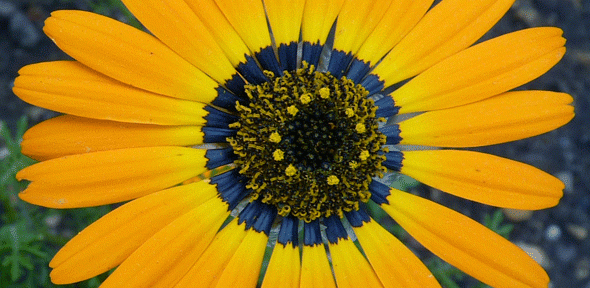
The base of the petals of daisy Ursinia speciosa contains a dark pigment but appears blue due to the presence of disordered striations on the cell surface. Image: Fred Lewsey, University of Cambridge
An interdisciplinary group of researchers which includes the department's Dr Silvia Vignolini, has found that 'messy' microscopic structures on the petals of some flowers manipulate light to produce a blue colour effect that is easily seen by bees.
These nanostructures scatter light particles in the blue to ultraviolet colour spectrum, generating a subtle effect that scientists have christened the ‘blue halo’.
By manufacturing artificial surfaces that replicated ‘blue halos’, scientists were able to test the effect on pollinators, in this case foraging bumblebees. They found that bees can see the blue halo, and use it as a signal to locate flowers more efficiently.
"The presence of these disordered photonic structures on their petals provides an alternative way to produce signals that attract insects.” Silvia Vignolini.
The study was conducted by a multidisciplinary team of scientists from the University of Cambridge’s Departments of Plant Sciences, Chemistry and Physics along with colleagues from the Royal Botanic Gardens Kew and the Adolphe Merkele Institute in Switzerland.
While the ridges and grooves on a petal surface line up next to each other “like a packet of dry spaghetti”, when analysing different flower species the researchers discovered they vary greatly in height, width and spacing – yet all produce a similar ‘blue halo’ effect.
In fact, even on a single petal these light-manipulating structures were found to be surprisingly irregular. This is a phenomenon physicists describe as ‘disorder’.
All the analysed flowers revealed significant levels of apparent ‘disorder’ in the dimensions and spacing of their petal nanostructures.
“The huge variety of petal anatomies, combined with the disordered nanostructures, would suggest that different flowers should have different optical properties,” said Vignolini.
“However, we observed that all these petal structures produce a similar visual effect in the blue-to-ultraviolet wavelength region of the spectrum – the blue halo.”
The researchers conclude that these “messy” petal nanostructures likely evolved independently many times across flowering plants, but reached the same luminous outcome that increases visibility to pollinators – an example of what’s known as ‘convergent evolution’.
The findings have been published in the journal Nature.
“We had always assumed that the disorder we saw in our petal surfaces was just an accidental by-product of life – that flowers couldn’t do any better,” said senior author Prof Beverley Glover, plant scientist and director of Cambridge’s Botanic Garden.
“It came as a real surprise to discover that the disorder itself is what generates the important optical signal that allows bees to find the flowers more effectively. The disorder in petal nanostructures appears to have been harnessed by evolution and ends up aiding floral communication with bees,” Glover said.
The scientists found several examples of halo-producing petals among two major flower groups (monocots and eudicots) that emerged during the Cretaceous period over 100 million years ago – coinciding with the early evolution of flower-visiting insects, in particular nectar-sucking bees.
Species the team found to have halo-producing petals included Oenothera stricta (a type of Evening Primrose), Ursinia speciosa (a member of the Daisy family) and Hibiscus trionum (known as ‘Flower-of-the-hour’).
Previous studies have shown that many species of bee have an innate preference for colours in the violet-blue range. However, plants do not always have the means to produce blue pigments.
“Many flowers lack the genetic and biochemical capability to manipulate pigment chemistry in the blue to ultraviolet spectrum,” said Vignolini. “The presence of these disordered photonic structures on their petals provides an alternative way to produce signals that attract insects.”
- Moyroud, E. et al. 'Disorder in convergent floral nanostructures enhances signalling to bees. Nature; 18th October 2017; DOI: 10.1038/nature24285
